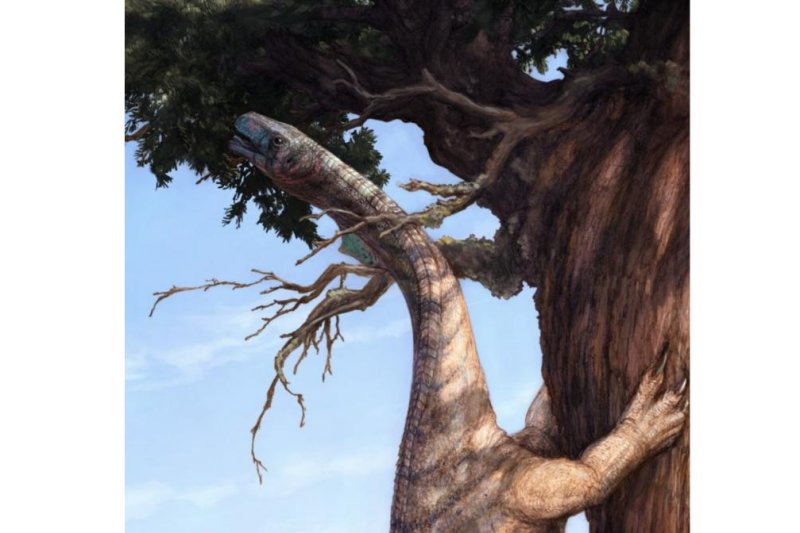An artist's rendering imagines the early sauropod relative Sarahsaurus aurifontanalis. Photo by Brain Engh/University of Texas
Oct. 11 (UPI) -- Sarahsaurus aurifontanalis, a new dinosaur species, is helping scientists understand how sauropods got so big.
Non-avian dinosaurs occupied Earth for 180 million years. During their time on the planet, dinosaurs evolved to enormous sizes. By the end of their reign, the largest sauropod, Brontosaurus, measured 100 feet tall and weighed 100 tons -- the largest land animal in Earth's history.
For paleontologists and evolutionary biologists, how and why dinosaurs grew to such tremendous dimensions has remained an intriguing and open question.
Researchers believe Sarahsaurus aurifontanalis is a close relative of the first sauropods. Sarahsaurus aurifontanalis lived during the Early Jurassic, about 185 million years ago. The species' unique features offer a preview of the direction in which sauropods would evolve.
"Sarahsaurus preserves in its anatomy the anatomical changes that were happening in the Late Triassic and Early Jurassic that were occurring in the evolutionary lineage," Adam Marsh, a paleontologist at Petrified Forest National Park, said in a news release. "It can help tell us how getting big happens."
Marsh, who conducted his analysis while earning his graduate degree at the University of Texas, described the newly named species this week in the journal PLOS One. He co-authored the paper with Timothy Rowe, professor at UT's Austin Jackson School of Geosciences.
The paper describes two Sarahsaurus aurifontanalis specimens, which were discovered and unearthed by Rowe in Arizona in 1997. The dinosaurs were found on land owned and managed by Navajo Nation. Though owned by Navajo Nation, the bones are cared for by the Jackson School Museum of Earth History Vertebrate Paleontology Collections.
"The specimens are well preserved in three dimensions and remarkably complete, which is very rare in the fossil record," said Matthew Brown, collections director at the museum. "Such complete specimens help paleontologists better understand the fragmentary and incomplete fossils remains we typically find."
Scientists liken the newly described species to a "ground sloth-like" dinosaur with many of the attributes of the earliest sauropods. But unlike the first sauropods, Sarahsaurus aurifontanalis displays some of the characteristics of later sauropods, including an increase in body size and the length of the neck vertebrae.
"It's starting to gain the characters of getting large compared to the earliest members of the group," Marsh said.
In comparing the new species to two closely related sauropod species in North America, scientists realized the three species lacked a common ancestor from the continent, suggesting the trio evolved from dinosaur lineages that migrated to North America independently.















